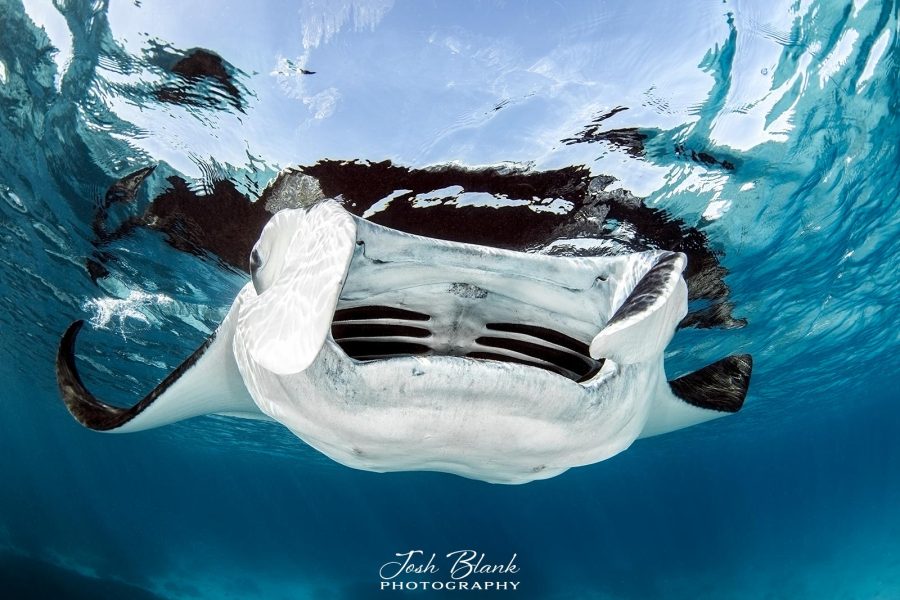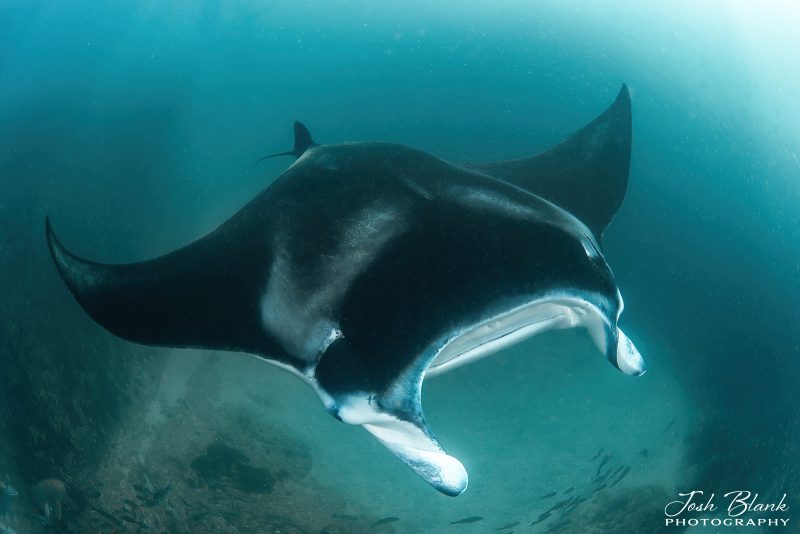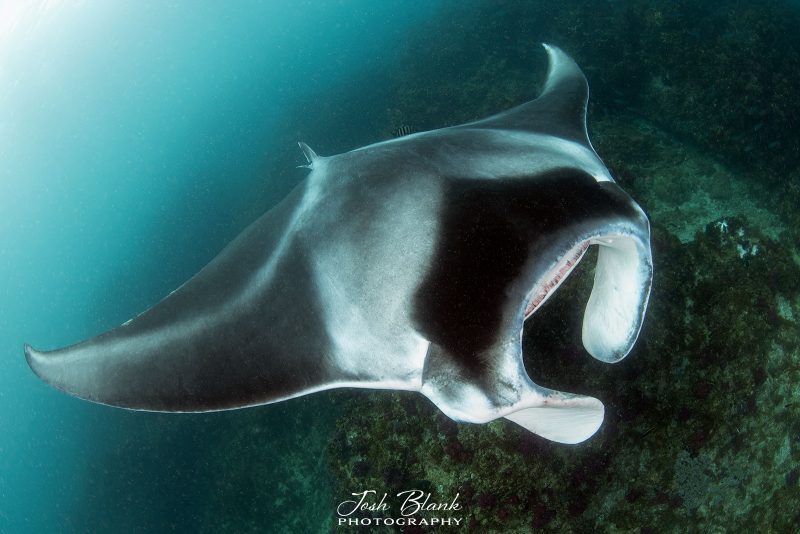How to Photograph Manta Rays

When it comes to the world of underwater photography, few species elicit the same degree of excitement as the majestic manta ray. Their often curious and charismatic demeanour, coupled with their notable size, puts them on the bucket list of just about every photographer to ever don a mask and fins.
Luckily, for the majority of divers around the world, it’s likely that you won’t have to travel too far to experience some manta magic, as there are currently multiple known locations around the globe.
With that being said, diving with manta rays and photographing them are two entirely different things. Photographing manta rays can be an incredibly rewarding experience, however, it can be equally frustrating if you find yourself unprepared for the encounter.
The following guide delves into everything you need to know to ensure you’re well prepared to capture that dream shot the next time you find yourself eye-to-eye with one of these ocean giants.
Some background about manta rays
Manta rays are known to be highly intelligent, and are in fact the largest species of ray in the world. Divers who have experience with manta rays will agree that this high level of intelligence is noticeable within the first few minutes of an interaction.
The unique way in which they often approach, with a healthy degree of self-preservation and a strong sense of curiosity, is unlike many other species of ray.
The term manta ray actually encompasses two different sub-species: reef mantas and oceanic mantas. Reef mantas are found relatively close to shore, usually on specific reefs or dive sites. This type of manta ray generally grows to a maximum width of three to four metres.
On the other hand oceanic mantas are much larger, growing up to seven metres across. These mantas are pelagic in nature, meaning they spend their lives cruising the deep blue.

Regardless of the type of manta ray you are diving with, it’s safe to assume you’re in for a truly unforgettable experience, with the potential for some amazing photographic opportunities!
Where to photograph manta rays
As mentioned already, there are a number of locations around the world where interactions with manta rays are not just possible, but are actually highly likely. Reef mantas typically frequent tropical and sub-tropical waters, whereas the oceanic variety have been sighted in temperate regions as well.
Manta rays can be seen at a number of popular diving destinations, including Australia, the Maldives, Hawaii, Mexico, and Indonesia, just to name a few (there are many more!).
Two particular destinations that, in my opinion, really stand out when it comes to photography are Lady Elliot Island in Australia, and the Revillagigedo Archipelago in Mexico.
Lady Elliot Island, Australia
Shallow depths, excellent visibility, and endless hours with lots of mantas: a recipe for some amazing images!
Lady Elliot Island is a coral cay located approximately 85 kilometres off the east coast of Australia. The surrounding waters make up the southern region of the Great Barrier Reef, and are an amazing spot for manta ray photography.

While finding an oceanic manta in these waters is highly unlikely, reef mantas are common year-round, and can be found in large numbers between the months of May and August.
Lady Elliot is a great destination for scuba divers, however, it’s the freediving and snorkelling that really deliver the best photographic opportunities. A big reason for this is that mantas are found directly off the shore.

Being able to swim out to the site by yourself allows for maximum time in the water, as well as being able to focus on the rays without the distraction of having many other people in the area.
Revillagigedo Archipelago, Mexico
With constant close encounters with oceanic manta rays basically guaranteed, it’s easy to understand why many divers rate the Revillagigedo Archipelago as the best destination in the world to photograph the species.
A 24 hour boat ride via liveaboard is required to reach this destination, but the rewards are well worth the effort!
This location is all about the oceanic variety, which are seen at just about every dive site in the area in large numbers. The primary reason why this site is rated so highly amongst photographers is due to the way in which the mantas behave.

The mantas of the archipelago seek out human interaction much more deliberately than at other destinations, and appear to enjoy the sensation of scuba diving bubbles on their bellies.
It’s not hard to imagine how having oceanic mantas lining up to hover above your head for extended periods of time would be quite helpful when it comes to composing images!
Scuba diving versus snorkelling
With the exception of photographing the bubble-loving manta rays of the Revillagigedo Archipelago, freediving or snorkelling is generally the preferred choice when it comes to photographing manta rays. Most mantas that you encounter will be a little more hesitant to approach closely in the presence of excessive bubble blowing.

Freediving allows for much greater manoeuvrability, and is also a lot less noisy and disruptive underwater. This often results in a more relaxed manta ray, and therefore a longer encounter allowing for more photographic opportunities.
Read more: Underwater Photography Ethics and Code of Conduct
Manta ray behaviour
Although curious, manta rays are also quite cautious, and won’t hesitate to leave the area within a heartbeat if they feel anything other than calm and relaxed.

For this reason, it’s very important for photographers to remain calm and composed, and always observe the animal for a few minutes before approaching for an image.
How to approach manta rays
Allowing the manta to become comfortable in your presence is extremely important. If scuba diving, minimise your bubbles as much as possible and avoid any sudden movements. If freediving, spend your first few dives giving the manta plenty of space, and monitor how it reacts to your presence.

Remember, if the manta appears at all disturbed, swim away and hope to find another one. Even if you somehow manage to capture a photograph of an agitated manta ray, I can promise you it won’t be the image you want!
Read more: Photographing a Species In-depth
Anticipation is key
While observing, take note of what the manta ray is doing. Is it being cleaned by cleaner wrasse? Is it feeding? Is it gliding in the water column? The answers to these questions will help you plan how to position yourself for the best possible encounter.

It’s not uncommon for manta rays to follow a regular loop while on a specific dive site. Identifying such information will go a long way in helping you anticipate the movements of the manta, which in turn will significantly improve your images.
Hope for feeding manta rays
Images captured during feeding events are the holy grail of manta ray photography. Nothing says ‘wow’ quite like an image of the enormous open mouth of a hungry manta as it engulfs large quantities of plankton.
Manta rays will usually be seen feeding on the surface, making this behaviour much more suitable to photograph while snorkelling or freediving. When feeding, mantas are typically focused on their meal and, as a result, behave much more boldly than usual, which is of course perfect for photography.

If you happen to see mantas swimming on the surface of the water, assume they are feeding and observe them for a minute or two. Approach slowly until you can see the rays underwater, avoiding any sudden movements. With a bit of luck you may have a manta ray turn inches from your camera, in spectacular fashion!
Camera equipment
As with all wildlife photography, your equipment plays an important role when it comes to capturing a successful image. I can’t stress enough that you don’t need an expensive camera to capture something special.

Some of the best manta ray images I’ve seen have been the product of a small, compact camera. With that being said, having the best equipment for the job will only help in your quest for jaw-dropping imagery.
Read more: What Equipment Do You Need for Underwater Photography?
Camera body
A camera capable of fast autofocus is important when it comes to manta ray photography. The quicker your camera is able to lock onto the subject, the better. The ability to use high speed, continuous shooting can also be very useful, particularly for photographers who prefer to shoot with natural light.
Camera lenses
When photographing manta rays, a wide-angle lens is your best option. Underwater photography is largely about getting as close as you can to your subject, to minimise the loss of light, contrast, and sharpness.
Wide-angle lenses also tend to have very close focusing abilities, which will allow you to get nice and close to capture all the intricate details on the manta ray’s body.

For full frame shooters, a fisheye lens, such as the 8-15mm from either Nikon or Canon, is an excellent choice. If using a cropped sensor, the ever popular Tokina 10-17mm is the way to go.
Strobes or natural light?
Natural light and strobe photography each have their place when it comes to capturing manta rays.
External lighting can be extremely beneficial for adding colour and sharpness to an image, as well as offering more potential compositions. However, strobes are typically large, bulky, and heavy, and it can be quite a nuisance to have to swim with all that extra weight.

If scuba diving, strobes are highly recommended in order to avoid blue and green washed images. If freediving the choice becomes more a matter of preference, as you will likely have plenty of available light between the surface and about 10 metres deep.
Regardless of how you dive, if your dream manta image is one of high contrast, detail, and sharpness, strobes will go a long way in helping you achieve your vision.
Read more: How to Choose a Strobe for Underwater Photography
Camera settings
There are obviously no ‘correct’ settings for capturing a particular subject when it comes to photography. Each photographer will always have their own style. However, it’s always helpful to have an idea on where to start for a particular subject.
Focus settings
Before entering the water, make sure your camera’s focus settings are appropriate for the task at hand. Due to manta rays being in a constant state of motion, a continuous autofocus mode is ideal, as well as utilising as many focus points as your camera allows.
When shooting, always keep an eye on the viewfinder as much as possible, to line up your primary focus point on your subject.
Shutter speed, aperture, and ISO
Depending on whether you are shooting with or without external lighting, your settings will vary.

This is mostly due to strobes having a maximum sync speed, which usually limits you to a max shutter speed of 1/250.
Read more: 6 Mistakes to Avoid When Taking Underwater Photos
Shooting with strobes
A shutter speed between 1/160 and 1/250, coupled with an aperture of f/8, is a good place to start when entering the water. ISO can then be used to balance exposure, however, remember to keep it within the parameters of your camera to avoid excessive noise.
Keep strobe power low to moderate, to allow for a quick recycle time. This is important, in order to allow for successive captures during a close interaction. Besides, a small burst of light from a close distance is often all that’s required, and will not disturb the manta ray.

Lastly, be mindful of the position of your strobes, to ensure a nice exposure while minimising backscatter. Start with each strobe positioned just a few inches from either side of your dome port.
Once in the water, take a few test shots of your dive buddy, and move each strobe either closer or further away from the dome to fine tune your lighting.
Read more: 5 Easy Ways to Avoid Backscatter in Underwater Photos
Shooting with natural light
Shooting with natural light means you will typically require a faster shutter speed in order to achieve a sharp image. A shutter speed of 1/500 or quicker is a good starting point to ensure you are able to freeze the motion of the manta ray. Open the aperture up nice and large (low f stop) to help balance for exposure, and adjust ISO slightly to fine tune.
Utilising your camera’s continuous shooting mode can be helpful for capturing multiple frames of a single close pass. However, remember to stay deliberate in your composition.

It can be tempting to shoot freely and hope for the best; this rarely pays off and will likely lead to many out of focus images. Always keep your eye on the view finder and think about the image you are creating.
Read more: 13 Ways to Improve Your Underwater Photos
Tips for composition
Now that you have knowledge on manta behaviour, useful equipment, and suggested camera settings, the next and final step is to have a plan for the kinds of images you are aiming to capture.
Here are a few tips to keep in mind when composing manta ray images.

Always approach manta rays slowly, first and foremost respecting the animal. Swimming towards them quickly or making sudden movements will startle the manta, resulting in a poor composition.
A general rule in underwater photography is to try and shoot in an upwards direction, to capture more light and involve more interesting scenery. This rule holds true for manta rays as well. However, rules are made to be broken! Shooting various downwards angles of the manta can provide greater emphasis on their sheer size.
Manta rays have a number of interesting features, including their unique underbellies, cephalic lobes, eyes, and wide-stretching pectoral fins. Aim to make either one or two of these features key points of your images.
Aim to photograph manta rays in as shallow water as possible. More available light means better colour, contrast, and sharpness, as well as offering interesting ocean textures along the surface of the water.

Be aware of the sun at all times, and use it to your advantage. If using strobes, shooting towards the sun can dramatically enhance your composition, by shooting sun bursts. If shooting with natural light, keeping the sun at your back will enhance colour, contrast, and sharpness.
Read more: Composition in Wildlife Photography: Getting Creative
In conclusion
So, there you have it: my guide to photographing manta rays. There is quite a lot to consider when it comes to photographing these majestic rays. However, my best piece of advice is to simply book a dive trip and get into the water with them!
Of course, keep all the technical stuff in mind but, as with all forms of photography, the most growth comes from getting out there and having a go!





